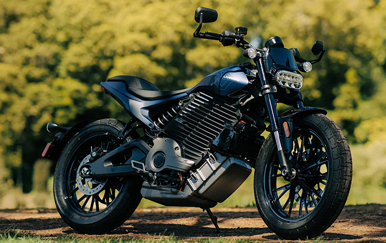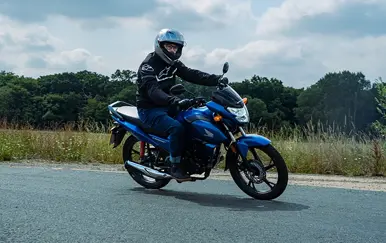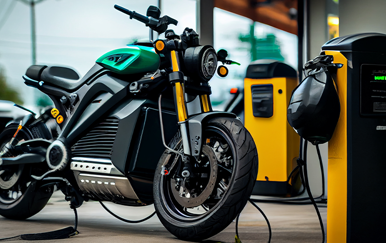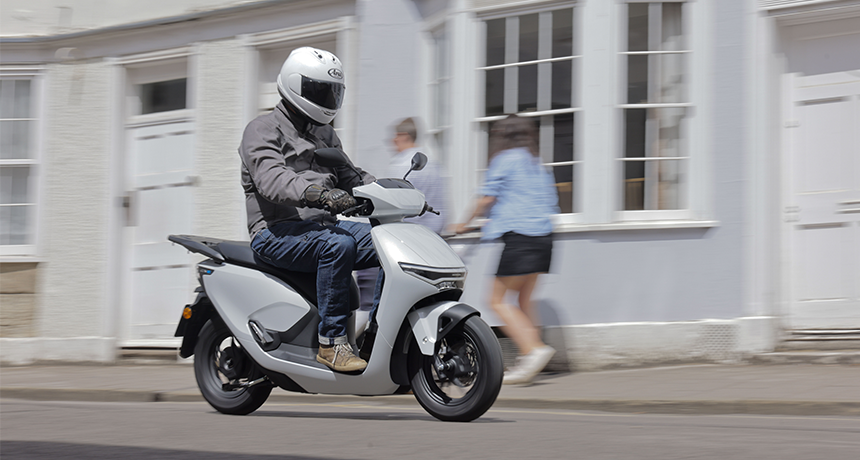
EV or electric bikes and scooters, while still lagging behind cars, remain a significant part of the future of powered two-wheelers with more and more varied models increasingly available – with one notable exception.
While there has been a wealth of new scooter offerings from emerging Chinese brands such as Super Soco, a steady stream of larger capacity motorcycles, most noticeably from dedicated American electric brand Zero and even a number of interesting, experimental machines from established, ‘heritage’ brands such as BMW and Harley-Davidson, one major part of the industry has so far remained pretty quiet – the Japanese.
That’s not exclusively the case, of course: Yamaha introduced its 50cc equivalent, AM-class Neo’s scooter in 2022, Honda unveiled its similarly-pitched EM1e the following year while compatriots Kawasaki have been probably the boldest of the bunch by launching two hybrids, the sports Ninja and roadster Z 7, plus two full-electric 125cc/A1 class equivalent Ninja e-1 and Z e-1 in 2024. In all honesty, however, none have had much commercial success. The Kawasakis have nearly all already had their prices almost halved while sales of the first two are, reportedly, pitiful.
But now there’s a new offering which has the potential to change all that.
The all-new CUVe: is Honda’s second electric offering for the European market following the EM1e, is targeting an arguably far more significant market and comes with a raft of features plus a sales proposition that seems substantially more appealing. And when the world’s largest powered two-wheeler manufacturer comes up with an electric machine that makes you sit up and take note, maybe that’s a significant landmark of the shape of things to come…
We attended the CUVe:’s European Press Launch in Oxford including spending half a day riding the new machine both around town and into the neighbouring countryside to see how it measured up…
2025 Honda CUVe: What is it?
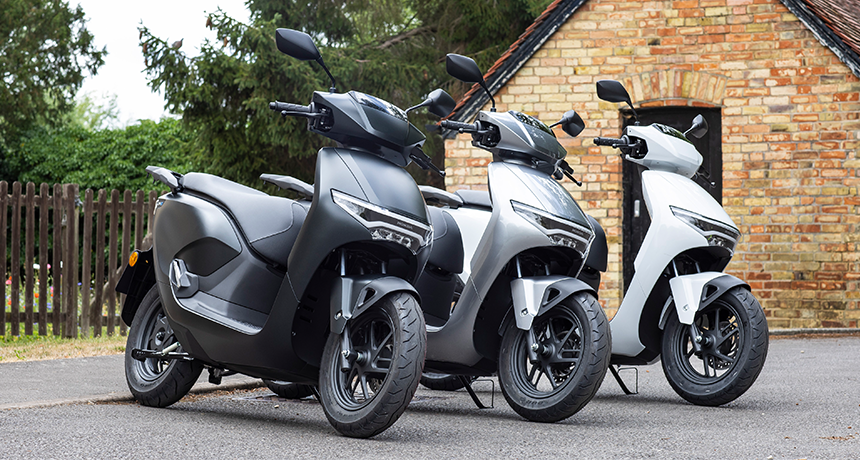
Let’s get the somewhat ‘clunky’ name out of the way with first: CUVe: stands for ‘Clean Urban Vehicle’ with the ‘e’ bit standing for, more obviously, ‘electric’. (The earlier EM1, incidentally, represented ‘Electric Moped’ with ‘1’ simply marking it as Honda’s first.) As for the colon on the end, no-one seemed to know what it meant, exactly, and I directly asked more than one Honda official on the launch…
The machine itself, however, is thankfully more straightforward. The CUVe: is a fairly conventional battery/electric 125cc/A1 class scooter but with more than a few highlight features that make it worth a second look.
Firstly, it’s not strictly speaking 125cc equivalent, although it’s still A1 compliant, and is instead intended to be equivalent in terms of performance with a 110cc ICE machine. Accordingly, its peak power is up to 6kW, which translates to about 8bhp (most 125cc ICE scooters produce somewhere between 10 and 15bhp) with a claimed top speed of 83kph (or 52mph, where many 125cc ICE machines are capable of 55-65mph).
The basic mechanics of that are a 6kW electric motor located, in a novel fashion, I the CUVe:’s bespoke aluminium swing arm rather than, as with many, being a ‘hub’ motor located inside the rear wheel.
The CUVe:’s battery design is novel, interesting and impressive, too. The new machine sees the debut of what Honda calls its MPPe – or ‘mobile power pack’. This comprises not one, but two removeable battery packs which slot in and out easily from under the seat. There’s two simply to aid portability– each weighs a manageable 10kg, if combined into one unit it’d be a far more awkward 20kg.
And that portability has been conceived to make recharging as easy as possible. The whole premise is that, instead of relying on an external, installed home charger, or commercial chargers, the CUVe: can be charged, easily, using home power sockets.
Two charging ‘docks’ come with the bike, can be simply plugged into a mains socket at home or in your garage and these automatically charge both batteries and monitor the charging process – all as easily as putting your phone or other appliance into a charging dock. It’s all simple, well-designed and, possibly, the future…
Most of the rest of the CUVe: is conventional but in many ways equally impressive. The frame is a typical scooter steel ‘underbone’ tubular spine affair; suspension brakes and wheels are nothing remarkable, save only for the latter being both 12in in diameter, so a good compromise between the 10-inchers often used on ‘dinky’ scoots and the 14 or even 15inchers found on maxi or sports scooters.
But the dash is a truly impressive 7inch TFT which is Bluetooth compatible and so, via Honda’s own app, able to display a quite sophisticated satnav and deliver calls and music. There are full-width, premium, LED lights all round; its keyless, there’s neat bespoke switchgear and even a useful cubby hole in the legshields containing a USB charging point for your phone.
The result is smart and slick with a premium touch, should be a doddle to ride and charge, being ULEZ compliant makes a brilliant city commuter and, perhaps most surprising of all, comes with a very tempting price, too…
2025 Honda CUVe: Price & Availability
Honda CUVe: £3800 (+OTR)
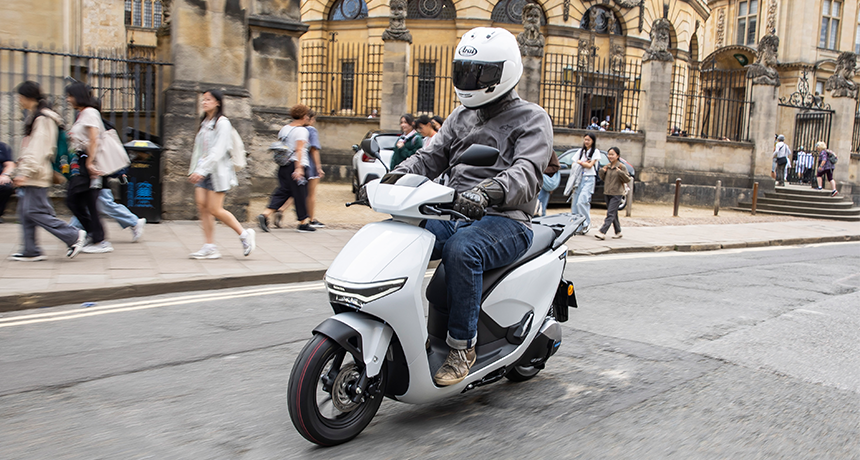
One of the biggest surprises on the CUVe:’s press launch in Oxford was the announcement of its price. The bike’s so new that, on arrival the final details of its pricing in the UK were still being worked out, although Honda UK officials were confident it’d be “under £4000” which is reasonably impressive in itself.
By the time we came to leave, however, those machinations had been concluded, and Honda were pleased to confirm that it’s actual price (when it goes on sale in the UK in September 2025) would be even cheaper still – at £3800.
And if that’s not tempting enough, think on this: as with all current Honda’s, the CUVe: also comes with Honda’s now across-the-board SIX years, unlimited mileage warranty and will also likely soon be offered with an equally tempting PCP deal, expected to be under £50 per month, which contrasts very temptingly to many Chinese electric scooters for which PCP deals sometimes aren’t available as residual values are so poor it’s impossible to calculate the ‘guaranteed future value’ necessary for such deals.
2025 Honda CUV e Engine | Silence is golden
Electric side motor | 6 kW / 8 bhp | 22 Nm | 3 modes
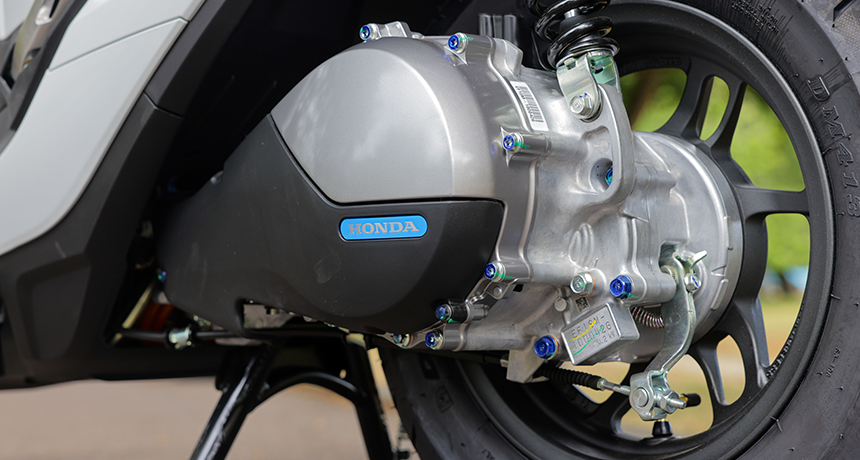
Being electric, and a slightly paltry 110cc equivalent one at that, there’s not that much to get excited about where the CUVe:’s ‘engine’ is concerned, but it’s still a valid, effective device.
The 6kW (max) unit is nothing exceptional in itself but, as mentioned, its mounted, not in the rear wheel hub as is often usual, but within the specially designed aluminium single-sided swing arm.
This has the dual benefit of reducing unsprung mass so benefitting handling by not overloading the suspension plus also improving accessibility to the rear wheel when it comes to tyre changes and so on.
Performance-wise, although unexceptional, it’s decent. There are three easily switchable power modes: Eco, Street and Sport, with the latter claimed to deliver a maximum speed of 83kph/52mph, although on our test we actually saw an indicated max of 59mph during one, long dual carriageway section.
Either way, that enough for most urban riding situations, even though Sport does drain the battery more quickly. If ridden more sensibly a battery range of 72 kilometres (45 miles) is claimed, which pretty much tallies with our experience on the test and should be enough for most owners’ usual commutes.
One aspect of the powertrain worth pointing out in addition is the excellent refinement of the whole unit, which I’d largely put down to Honda’s thoroughness of design. Starting is simple – being keyless just turn the legshield power knob to on, thumb the starter and you’re ready to twist and go. Then, on the move, the throttle response and feeling of connection to the drive is glitch-free, smooth and… silent.
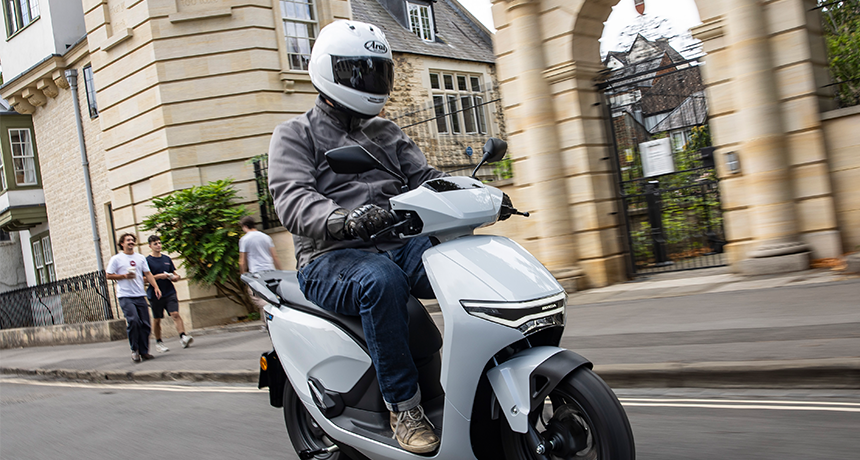
Our test ride started at a hotel on the outskirts of Oxford before our chaparoned group of about eight bikes swept through and out the other side of the historic university city then back on ever faster open roads to the quaint village of Woodstock. There we rode for and took some photographs before returning to Oxford city centre, doing some more photographs, then heading back to the hotel. All told we covered about 35 miles over three or four hours.
First impressions of the CUVe: are dominated by its proportions – and ease. It’s a little on the dinky side for my 6’3” but it’s not a problem. It’s light and small enough to feel instantly in control of, yet is also sufficiently sizeable and substantial on which to feel secure at commuting speed.
Starting then setting off is such a breeze I comfortably do a couple of feet-up U-twins before joining the tail end of the riding group. Throttle response is so precise and predictable I feel I can place the CUVe: on the proverbial sixpence and, within seconds, after traversing the hotel’s drive, we’re all riding in staggered formation on a main road into town.
The ride is smooth enough and the whole machine confidence inspiring, but it’s not perfect. Potholes, speed bumps and raised, ramped zebra crossings jar annoyingly as the fairly basic suspension crashes or bottoms out. Neither the front 26mm telescopic forks nor single rear shock have any sort of adjustment. But it’s not a major problem, is pretty much what I expected from this class of machine and luckily the CUVe: is so manoeuvrable and controllable it’s easy to simply wiggle around potholes or problems.
The big 7in TFT dash impresses immediately, too – so much so that, especially when set in satnav mode, displaying a ‘zoom-inable map of the local area, it’s also quite a distraction.
While the all-round comfort, class and ease of the CUVe: immediately impresses in these early miles, too, with the riding position and comfort completely natural, the controls all effective, quality and intuitive, and the machine’s dynamics exceeding expectations, too.
Honda CUV e Handling | Winding on to Woodstock
120 kg | 760mm seat | 1,310mm wheelbase | 145mm ground clearance | 26mm telescopic forks & Monoshock rear
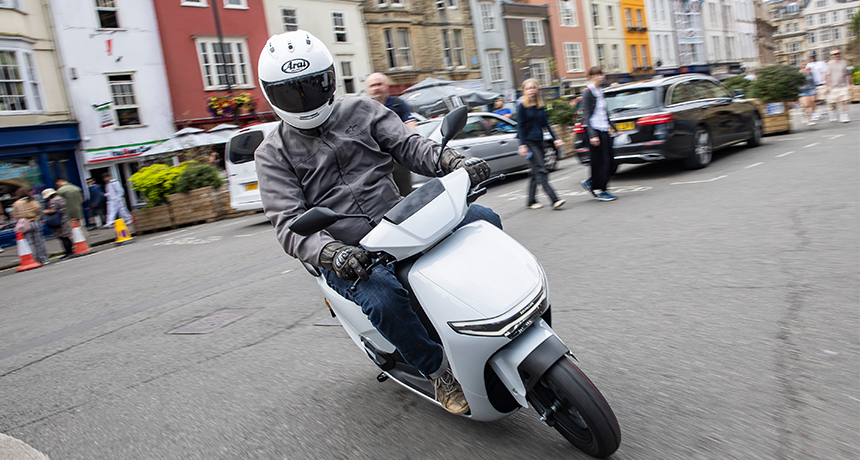
As the 20 and 30mph limits open up into suburban straights, speeds rise, too, and the CUVe: continues to impress. I’d started out in Street mode, which is brisk enough, but now, as we head out of town towards Woodstock, it’s time for Sport.
On our first dual carriageway it’s time to see what it’ll do: and if you hold the throttle wide open, duck your head down out of the wind for a while and wait, the answer, eventually, is 59mph. No, not earth shattering, but decent and probably enough considering its intended use although I have to add that, at this speed and in this mode, the %-age remaining battery life does almost tick down right in front of your eyes.
Ring road roundabouts and national limit country roads also bring the opportunity to suss out the CUVe:’s handling and, for the most part, that’s pretty good, too. The 12inch wheel combination means that, while quick steering and nimble, it’s not too twitchy, which is sometimes a fault of scooters fitted with 10inch wheels.
Away from the potholes and speed bumps the suspension is more than acceptable and the riding position, being a nice compromise between being a small or large scooter, is mostly beyond criticism, too.
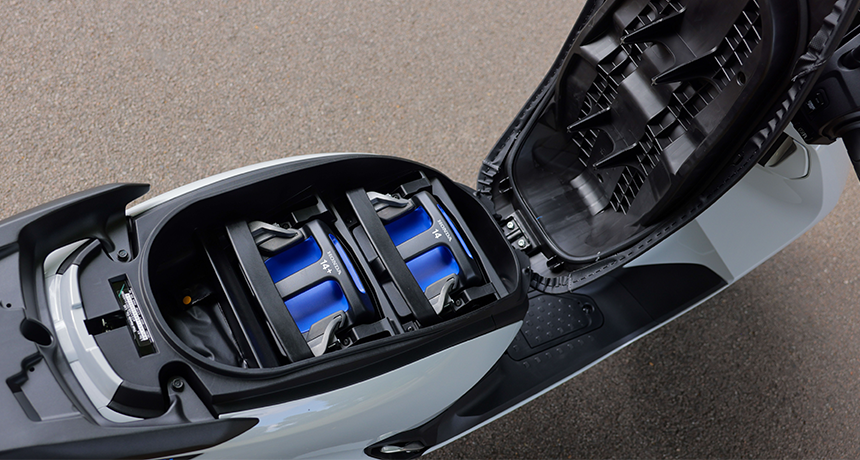
After more photos then a coffee break, we remount to head back into town and I reflect on how quietly capable the CUVe: is. It’s smart and smooth without being ostentatious (it is a Honda, after all); it’s easy and intuitive as the best domestic appliances are; it has a sweet sprinkling of premium quality (the dash, being keyless, the flash, full-width LED lights); its removeable battery system seems to me to be a masterstroke and, although its performance is pretty much what you expect, there’s a refinement and reassurance here that sometimes only Honda products bring.
As we hit the drag into central Oxford I’m approached on the other side of the road by a loud-piped R1 and, by contrast to the silent, clean, ultra-modern CUVe:, it comes over as all fire and brimstone, like something from Dante’s Inferno, all noise, smoke and smells – like a traction or steam engine, even. Maybe I am becoming an electric convert, after all…
2025 Honda CUVe Features
Dash: 7” TFT dash | three modes | Traction Control | Keyless | Reverse Assist
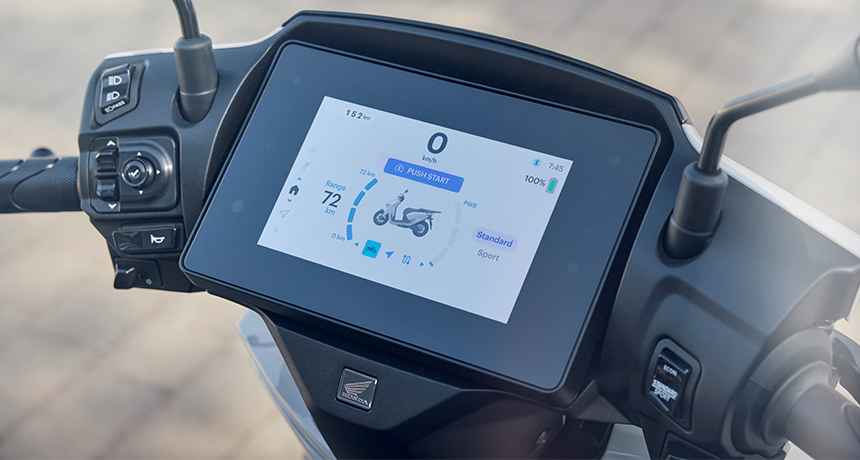
Although difficult to describe as ‘luxurious’ and, because of its affordable ‘ticket’, inevitably built down to a price, the CUVe: still manages to evoke a sense of premium quality – and that’s down to both its smooth, slick styling but, even more so, by quality equipment where it counts.
The 7in colour TFT dash is the standout example, is effective and comprehensive, easy to navigate via its equally slick, bespoke switchgear, has the bonus of being able to offer via Bluetooth and Honda’s latest Roadsync Duo phone app, an impressive satnav system along with the expected calls and music and is head and shoulders above anything similar currently offered in this class.
But it’s not alone. The removeable battery system is similarly impressive, the brakes comes with Honda’s linked CBS system with rudimentary traction control and there’s even a reverse ‘gear’ to assist with parking manouvering: Simply prod the ‘R’ button next to the starter on the right bar, correspondingly press the ‘down’ button on the left bar and away, slightly disorientingly at first, you go – and also up to a potential 3mph, one more than possible on Honda’s other so equipped bike, the Gold Wing.
Few scooters, and certainly none so affordable or by Honda, have ever come so equipped.
2025 Honda CUV e Performance | Town or Travelling
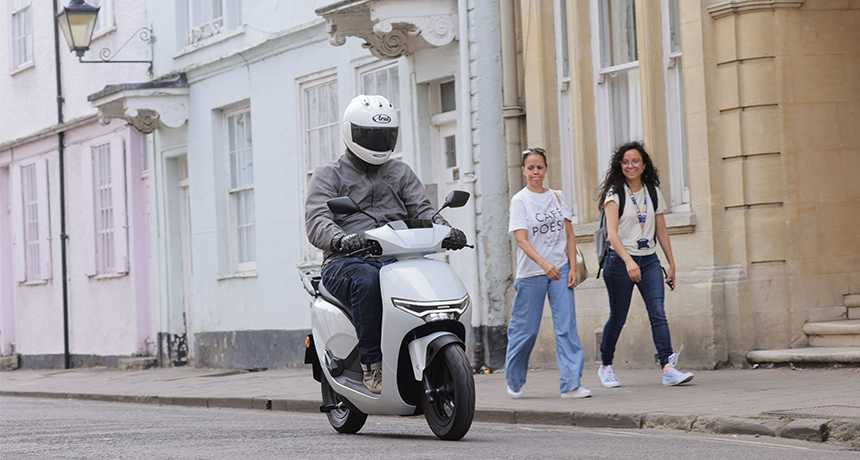
Our half day test proved something else about the new CUVe:, too. While to some degree capable of heading a little out of town as we did to Woodstock, it’s also not its true forte. The biggest part of the new Honda’s appeal is in town and is where it’s truly hugely appealing.
Not only does it have sufficient, net zero performance which is delivered with a refined feel and precision few electric scooters can currently match. It’s also completely effortless and intuitive to ride, can be ridden and parked virtually anywhere and its TFT dash and battery system make living with one joyfully easy, too. It’s not perfect – nothing is.
The indicators annoyed slightly by not self-cancelling, on full-lock my knees bashed the bars a bit and, due to those two batteries, barely any luggage space remains under the seat. But I can live with those and, besides, at this price, and with a Honda accessory list including things like a slick, colour-matched top box, it not that much of a problem anyway…
Pros
-
Great price
-
Slick features and quality
-
Novel battery system
Cons
-
Not available until September
-
Taller riders' knees may clash
-
Non-cancelling indicators
2025 Honda CUVe: Verdict
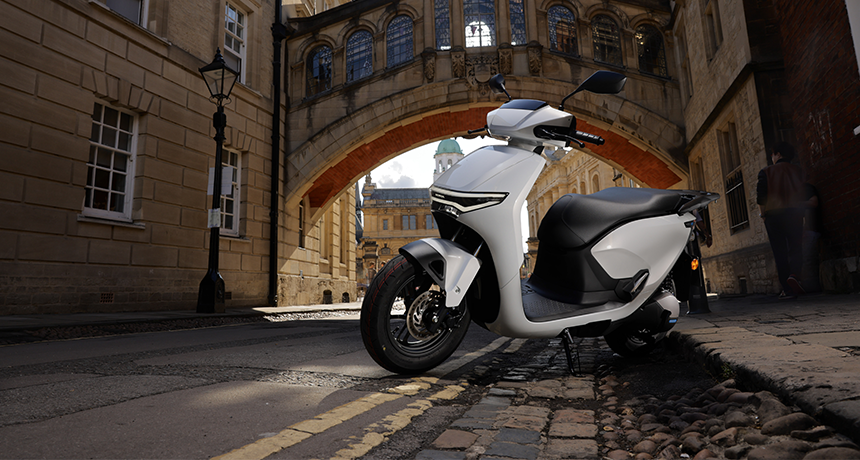
On face value, the CUVe: not only has the currently limited appeal of being an electric scooter it also appears to bring little new to the category.
In reality, it’s far better – and far more significant than that.
First, it shouldn’t be underestimated how significant it is as Honda’s only second European EV offering. Being A1-compliant broadens the appeal; the novel removable battery system is, simply, brilliant; its TFT dash and other features add a premium feel while its price, at just £3800, should make more than a few potential buyers think twice.
As a result, the CUVe: should be Honda’s most successful European product so far that will pave the way for even bolder more innovative designs in the future, perhaps again including the MPPe system. We know more full-size maybe motorcycle EVs are expected from Honda this fall. Maybe now is the time to start getting really excited about them…
Thanks to Honda UK for having us on the European launch, check the full specs and information at https://www.honda.co.uk .



